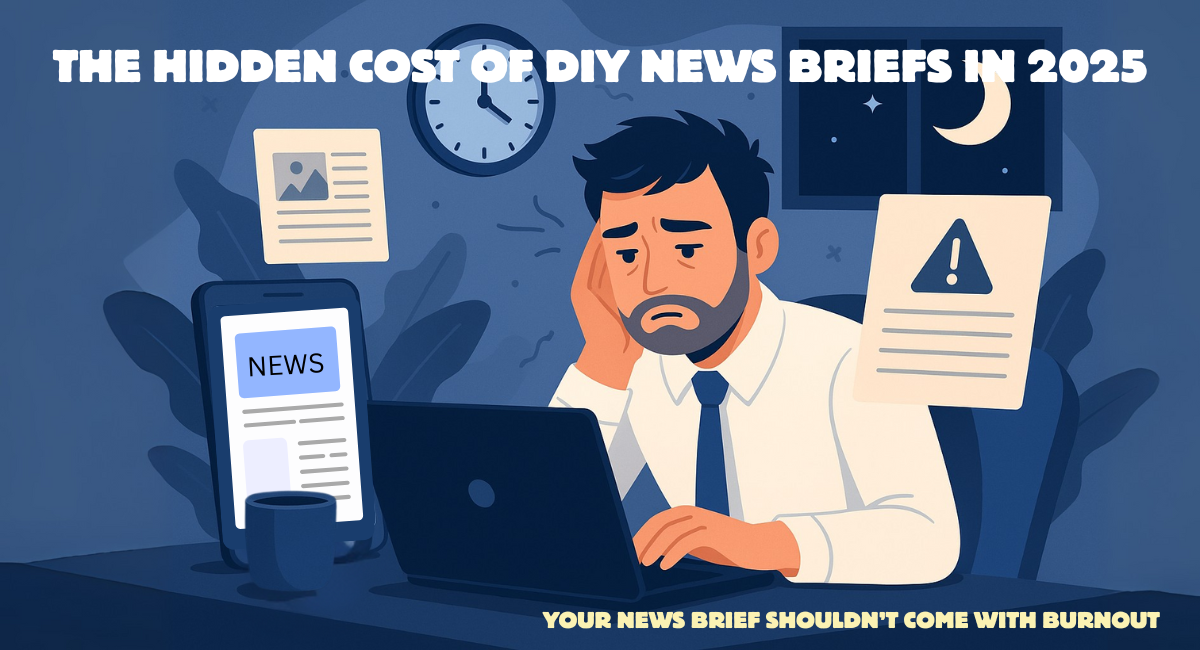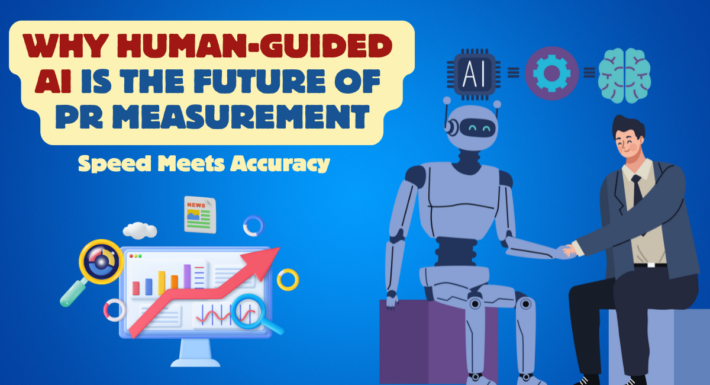Why Smart PR Teams Are Ditching DIY Media Monitoring in 2025: The Real Cost of Managing Your Own Executive News Briefs

It’s 5 AM, and while most of the world sleeps, someone on your PR team is frantically scrolling through hundreds of articles for your executive news brief. Sound familiar? You’re not alone.
As someone who’s spent years optimizing media monitoring workflows and implementing AI solutions for crisis communication, I’ve witnessed how the landscape of executive news briefs has evolved—and why the DIY approach is becoming more costly and painful than ever for PR professionals.
Why Executive News Briefs Make or Break PR Credibility
Your executive news brief is your organization’s daily compass. Just as a compass helps navigate unfamiliar terrain, these morning briefings guide leadership through the ever-changing media landscape. They’re delivered before 9 a.m. and contain the most relevant news from the past 24 hours—brand mentions, competitor activities, industry developments, and potential crises.
The best executive news briefs are strategic intelligence reports that include traditional and social media content, competitor analysis, reach metrics, and mobile-friendly formatting. In 2025, with AI capabilities advancing rapidly and media volumes exploding across digital channels, how organizations create these briefings has become a make-or-break decision for both budget and team satisfaction.
Three PR Approaches to Executive News Briefs: Which Path Protects Your Reputation?
Today’s PR teams—whether in-house communications departments or agencies serving multiple clients—typically choose one of three paths for their executive news briefings, each with dramatically different outcomes:
The “Set It and Forget It” Automation Trap
This approach is like having a fishing net with holes—you’ll catch something, but miss the big fish that matter most. Automated systems use preset search terms and Boolean logic across news aggregation feeds. While this might seem efficient for busy PR teams, it often results in irrelevant content mixed with missed opportunities that could become reputation risks.
News publishers are increasingly restricting automated access. Premium sources are opting out of aggregation feeds, and crisis-worthy stories get trapped behind paywalls. Your PR team spends precious morning hours cleaning up irrelevant content while potentially missing critical stories. When you exceed usage limits, costs can skyrocket faster than you can explain to budget-conscious leadership.
The “We’ll Handle Everything In-House” Marathon
Your PR team controls every aspect of the process—monitoring, curation, quality control, and distribution. This sounds perfect for maintaining PR standards and client relationships.
But here’s the reality: Someone on your team needs to start their day at 5 AM to meet that 8 AM executive delivery deadline. It’s like having your most talented PR professionals moonlight as newspaper editors, except they’re probably not thrilled about sacrificing sleep for daily briefing duties.
The Strategic Partnership Advantage
This approach combines advanced technology with communications expertise. Professional media analysts work with AI-powered tools to create comprehensive briefings, like having a dedicated research team that understands PR priorities and crisis prevention.
These analysts become extensions of your PR team, learning your industry language, understanding your competitive landscape, and developing an intuitive sense of what matters most for reputation management and strategic communications.
The Hidden Costs That Undermine PR Team Performance
When I analyze the actual cost of different approaches to executive news briefings, the numbers often surprise PR leaders. According to Fullintel’s detailed analysis, here’s what communications budgets actually look like:
- In-house production using SaaS tools: Approximately USD 56,000 annually
- In-house production through PR agencies: Around USD 153,960 annually
- Expert curation services: Typically 30-60% less than the above options
But these numbers only tell part of the story. The hidden costs are where PR teams really feel the impact on their effectiveness and job satisfaction.
The Early Morning Burnout Factor That’s Killing PR Talent
Any PR professional responsible for daily news briefs knows about the “4 AM club”—communicators who drag themselves out of bed before dawn to ensure executives get their morning briefing on time. This isn’t just unsustainable; it’s a recipe for losing your best PR talent.
For agencies, this challenge multiplies across multiple client accounts. This leads to higher turnover in communications teams, constant training of new staff, and the perpetual challenge of finding qualified backup coverage.
When Strategic PR Work Takes a Back Seat to Manual Tasks
When your PR team spends significant time on media monitoring and brief creation, it’s like asking a skilled crisis manager to handle data entry. I’ve seen talented PR professionals become so consumed with news brief production mechanics that they lose focus on relationship building, crisis prevention, and strategic campaign development—the activities that truly protect and enhance organizational reputation.
For agencies, this means billable hours spent on low-value tasks instead of strategic consulting for which clients pay premium rates.
The Consistency Crisis That Damages Credibility
Without dedicated expertise, PR teams often struggle with consistency and accuracy in their briefings. It’s like having different team members interpret the same media landscape—you’ll get different priorities, missed crisis signals, and occasional errors that could undermine your credibility with executive leadership or clients.
How AI is Transforming PR Media Monitoring in 2025 and Beyond
Here’s where my experience with AI implementation becomes particularly relevant for PR professionals. In 2025, we’re seeing unprecedented advances in natural language processing and content analysis that are specifically valuable for communications teams. However—and this is crucial for PR success—AI works best when it’s guided by communications expertise, not when it’s running on autopilot.
The most effective executive news briefing solutions now combine AI-powered content discovery with human analysts who understand PR priorities, crisis indicators, and strategic communications context. It’s like having a research assistant who can quickly scan thousands of articles but an experienced PR professional who knows which ones signal potential reputation risks or strategic opportunities.
This hybrid approach addresses the classic weaknesses that can hurt PR effectiveness: false positives that waste your time, missed context that could indicate brewing issues, and irrelevant content that dilutes your strategic focus. Meanwhile, it eliminates the human limitations of early morning fatigue and the inability to process large volumes of information quickly enough to spot emerging trends.
Why Smart PR Teams Are Choosing Expert Curation
When PR teams partner with expert curation services, they’re essentially adding specialized capabilities to their communications arsenal. This is similar to how most teams work with specialized vendors for media distribution or crisis monitoring rather than building those capabilities in-house.
The economics make sense for PR budgets: Expert services typically deliver 30-60% cost savings compared to in-house production, while providing superior quality and consistency. But the real value for PR professionals lies in what your team can accomplish when they’re not spending hours each morning on manual content curation.
Your communications professionals can focus on stakeholder relationship building, crisis prevention and response, strategic campaign development, and media relations—activities that directly impact your organization’s reputation and require genuine PR expertise. For agencies, this means more time for strategic consulting and client relationship building, which commands higher billing rates.
What Forward-Thinking PR Leaders Are Doing Right Now
Smart PR leaders recognize that media monitoring and brief curation have become specialized functions that require dedicated expertise, advanced technology, and round-the-clock attention. Just as you wouldn’t ask your crisis communications team to handle IT support, it may be time to reconsider whether your PR professionals should handle the technical aspects of content aggregation and data processing.
The most successful executive news brief programs I’ve observed combine three essential elements: advanced AI-powered monitoring capabilities that catch emerging issues early, human expertise in content curation and analysis that understands communications priorities, and seamless integration with existing PR workflows and crisis management protocols.
Action Steps for PR Leaders Ready to Optimize Their Media Monitoring
If your PR team is currently managing executive news briefs in-house, calculate the actual cost, including staff time, technology expenses, and the opportunity cost of having skilled communications professionals focused on routine tasks rather than strategic initiatives that protect and enhance reputation.
Consider conducting a simple audit with your team: Track how many hours your PR professionals spend each week on news brief production, multiply by their hourly rates, and add your technology costs. The number might surprise you, especially when you consider what else that time could accomplish for your organization’s communications goals.
More importantly, have an honest conversation with your PR team about job satisfaction and workload balance. Are your best communicators spending their time on activities that leverage their strategic thinking abilities and media relations expertise, or are they caught up in the daily grind of content curation and data processing?
The media landscape will only continue to grow more complex, with new platforms, increased content volume, and evolving crisis scenarios that require rapid response. The question is: Will your PR team be ready to navigate these challenges with the right tools and expertise, or will you be stuck managing the mechanics of media monitoring while missing the strategic opportunities that drive real communications success?
Ted Skinner
Ted Skinner is the Vice President of Marketing at Fullintel. With extensive experience in crisis communication strategy and media monitoring best practices, Ted has helped organizations optimize their morning media monitoring workflows and implement AI-driven solutions for competitive intelligence. His work focuses on bridging the gap between complex technical capabilities and real-world PR applications, helping communications professionals leverage advanced tools without losing the strategic focus that drives successful public relations outcomes.
Follow Ted’s insights on LinkedIn at linkedin.com/in/tedskinner or read more of his analysis at fullintel.com/author/ted-skinner.
With decades of marketing and PR expertise honed from his early work at eWatch—one of the original pioneers in online media monitoring—Ted Skinner’s insights aren’t just historical footnotes. They’re strategic catalysts, drawing on data-driven analysis and a nuanced understanding of the evolving communications ecosystem, empowering organizations to make informed, forward-looking decisions that drive sustained growth and long-term market advantage.




